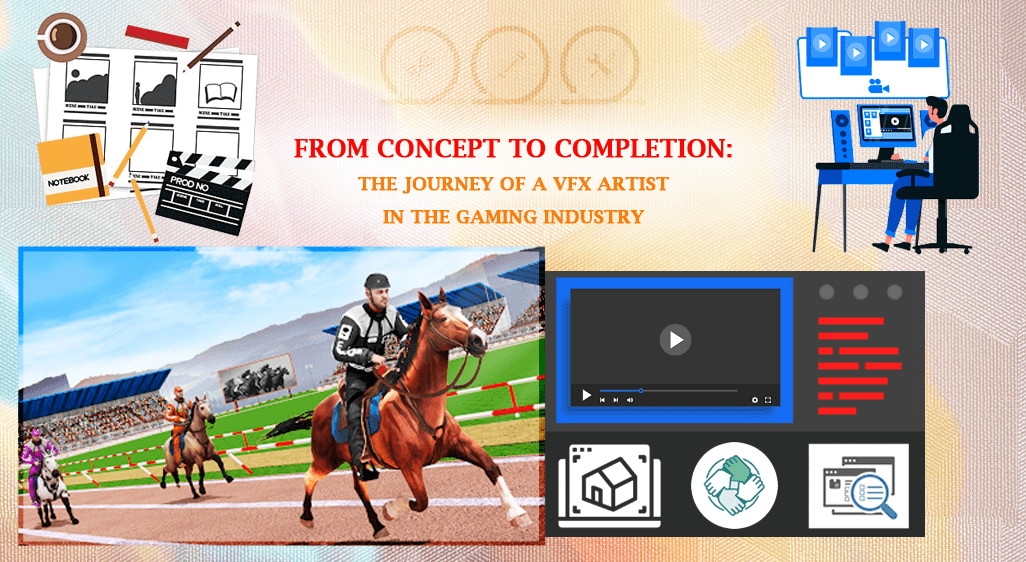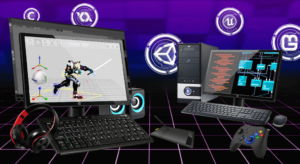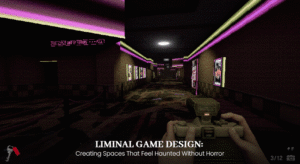
From Concept to Completion: The Journey of a VFX Artist in the Gaming Industry
Imagine stepping into a virtual world where every detail is meticulously crafted to captivate your senses. The glow of neon signs illuminating a cyberpunk cityscape, the roar of dragons soaring across a fantastical realm, or the shimmering magic spells weaving through an enchanted forest—all brought to life through the artistry of visual effects.
In the gaming industry, VFX artists are the unsung heroes behind these breathtaking spectacles, playing a pivotal role in transforming mere ideas into immersive digital experiences. From the initial spark of inspiration to the final flourish of polish, their journey is a testament to creativity, technical prowess, and relentless dedication. This blog is a detailed exploration of the world of VFX artistry, focusing on the journey of a VFX artist in the gaming industry. The journey involves the inception of ideas and their realization in the ever-evolving gaming landscape. The journey is filled with passion, imagination, and awe-inspiring pixels, allowing readers to witness the magic behind the scenes.
Understanding the Role of a VFX Artist
VFX (visual effects) is a crucial aspect of modern gaming aesthetics, enhancing the visual appeal and immersive experience of video games. VFX artists use a variety of techniques and technologies to create visually stunning visuals, from explosions and dynamic weather effects to intricate character animations and realistic environments. They are akin to digital maestros, using software tools and artistic prowess to create visually stunning visuals that serve a functional purpose within the game world. This requires a deep understanding of game design principles, technical proficiency in 3D modelling and animation, and a creative flair to push the boundaries of visual storytelling.
In the gaming industry, collaboration is essential for successful VFX production. VFX artists often work with a diverse array of talents, including game designers, programmers, animators, and sound engineers. This collaboration ensures that VFX seamlessly integrates with other aspects of game development, enhancing gameplay mechanics and narrative immersion. Effective communication and teamwork are the bedrock of successful VFX production. VFX artists craft meaningful experiences that resonate with players on a profound level, requiring technical expertise, artistic vision, and a collaborative spirit.
Conceptualization and Pre-production Phase
Ideation Process
The conceptualisation and pre-production phase of VFX development is a crucial stage where ideas take shape, dreams are born, and the groundwork for stunning visual experiences is laid. It begins with brainstorming sessions, where imaginations run wild and ideas flow freely. VFX artists often use mood boards and concept art to give shape to abstract concepts, which serve as visual treasure maps and blueprints for VFX concepts.
Storyboarding
The storyboard phase is the storyteller’s canvas, where VFX sequences are mapped out in meticulous detail. Storyboarding is not just about sketching pretty pictures; it’s about crafting visual narratives that resonate with players on an emotional level. It helps artists visualize the flow of action, camera angles, and timing of effects, laying the groundwork for seamless integration of VFX into the game’s narrative, enhancing immersion and storytelling depth.
Prototyping and Iteration
The prototyping and iteration phase is the proving ground where VFX concepts are put to the test and refined through a process of trial and error. This isn’t a one-and-done affair; it’s a journey of continuous refinement and iteration. Prototyping allows VFX artists to experiment with different techniques and effects, exploring the possibilities and pushing the boundaries of creativity. Through rigorous feedback and iteration, artists fine-tune their designs, ironing out wrinkles and polishing rough edges until they achieve visual perfection.
Production Phase: Bringing VFX to Life
The production phase of VFX production involves the creation of 3D models, textures, and animations, which are meticulously crafted by VFX artists using specialised software. These models are like sculpting in the digital world, with intricate character designs and sprawling landscapes. Textures add depth and realism to these models, imbuing them with texture and personality. Animations are the heartbeat of VFX, bringing characters to life and infusing them with personality and emotion.
Special effects are another crucial aspect of VFX, adding depth, dynamism, and excitement to the game world. Particle systems, like paintbrushes, allow artists to create dazzling visual effects such as explosions, fire, smoke, and magical spells. They add a touch of spectacle to the gaming experience, leaving players spellbound. Shaders, on the other hand, control how light interacts with objects in the game world, creating stunning visual effects such as reflections, refractions, and shadows.
Integration with gameplay mechanics is also crucial. VFX artists collaborate closely with game designers to ensure that visual effects enhance gameplay, rather than detract from it. Visual effects play a vital role in shaping the player experience, serving a purpose and contributing to the game’s overall vision.
The production phase of VFX development is a whirlwind of creativity, innovation, and collaboration, where artists bring their wildest dreams to life and immerse players in captivating digital worlds. By focusing on asset creation, special effects, and integration with gameplay mechanics, VFX artists create immersive experiences for players.
Post-production and optimization
Post-production and optimisation are crucial stages in the development of visual effects (VFX) for games. These stages involve meticulous attention to detail, ensuring every pixel is perfect and every frame is flawless. Rendering is the process of generating images from 3D models, textures, and animations using specialised software called rendering engines. These engines calculate complex lighting, shading, and perspective effects that give VFX their realism and depth.
Rendering
Rendering is not just about brute force; it’s also about finesse and optimisation. VFX artists carefully tweak rendering settings to strike the perfect balance between visual quality and performance. This includes adjusting lighting parameters, optimizing shader effects, or fine-tuning rendering techniques to produce high-quality visuals that immerse players in the game world.
Optimization Techniques
Optimization techniques ensure VFX maintains performance without sacrificing visual impact. Level of detail (LOD) management dynamically adjusts the detail of 3D models based on their distance from the camera, reducing rendering overhead without compromising visual fidelity. Another optimization strategy is texture compression, which reduces the memory footprint of textures without significantly impacting visual quality. Techniques such as mipmapping and texture atlases maximize texture detail while minimizing memory usage, resulting in faster load times and smoother gameplay.
Feedback and Iteration
Feedback and iteration are vital processes in post-production. VFX artists engage in a constant cycle of iteration, refining their work based on feedback from stakeholders and playtesters. Every iteration brings VFX one step closer to perfection. The post-production and optimisation phase of VFX development is a whirlwind of creativity, innovation, and collaboration, where artists strive for perfection and never settle for anything less.
Launch and Beyond
Launch Day
Launch day is a crucial moment in the gaming industry, where VFX artists create captivating digital worlds for players. However, the journey goes beyond just gameplay; VFX artists also play a vital role in marketing and promotion, creating eye-catching trailers, promotional materials, and advertisements that build hype and excitement for the game. They capture the imagination of gamers by showcasing the game’s world, characters, and mechanics.
Community Engagement
Community engagement is another important aspect of the game’s life cycle. VFX artists continue to engage with the gaming community, soliciting feedback and addressing issues to ensure the game’s success. This can take various forms, such as participating in forums, hosting live streams, and hosting developer Q&A sessions. They listen attentively to player feedback, taking note of bugs, glitches, and suggestions for improvements.
Future Developments
Future developments in VFX in gaming include real-time ray tracing, a cutting-edge rendering technique that simulates light behaviour in real-time, and virtual reality (VR), offering unprecedented levels of immersion and interactivity. These technologies offer immersive experiences that transport players to new realms of imagination and wonder.
The most exciting aspect of the future of VFX in gaming is the limitless potential for innovation and creativity. As technology evolves and boundaries are pushed, VFX artists will continue to push the envelope, creating experiences that redefine the essence of gaming. As we bid farewell to launch day, the journey of VFX in gaming is far from over, filled with excitement, innovation, and endless possibilities.
The journey of a VFX artist in the gaming industry is a testament to creativity, innovation, and dedication. From the inception of an idea to its realisation in the gaming landscape, the journey is a whirlwind of creativity and collaboration. Beyond the technical intricacies and artistic flourishes, VFX artists have a profound impact on the gaming experience. They are the architects of immersion, masters of spectacle, and guardians of imagination. Their artistry and ingenuity transport players to new worlds, ignite their imagination and leave a lasting impression on their hearts and minds.
As we bid farewell to this journey, we encourage readers to embark on their adventure into the world of VFX and game development. Arena Animations, Park Street, offers a wide range of courses in VFX and game development, designed to equip individuals with the skills and knowledge needed to succeed in this exciting industry. Join us on a journey of discovery, creativity, and endless possibility, as the world of VFX and game development awaits.












